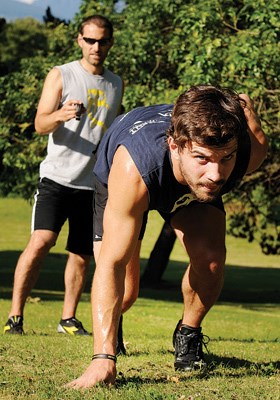What's a picture worth? A YouTube clip, a blog post about a new arena in northern B.C., or a tutorial on building an obscure and specialized device for improving the stride of a speed skater?
Kevin Jagger is occupied with such questions. The 27-year-old Â鶹´«Ã½Ó³»College graduate left his well-paying Toronto job as an investment bank analyst in April last year to chase the Olympic dream. Inspired by athletes at the 2010 Winter Games, Jagger decided to join them.
He instigated a major life overhaul. But he also knew one of his new and most pressing responsibilities-if he was going to qualify for the Canadian men's national speed skating team, one of the best on the planet-was to turn a buck.
Amateur athletes have bills to pay. If they are to train for hours each day for years of their life, the wouldbe gold-medal-winners and national idols have to subsidize the cost of rent, groceries, coaching, equipment and travel on their way to the podium, a destination most don't even get close enough to smell.
"Ninety-nine per cent of my hesitancy in pursuing this dream revolved around financial security," Jagger acknowledged after he spent the winter training at the Olympic Oval in Calgary where he relocated and shared ice time with skaters 10 years his junior.
Jagger met his athletic goals this year. He cracked the top-100 male speed skaters in Canada. (He's ranked 90th.) And surpassed his 40second goal by skating the 500 metre sprint in 39.35 seconds. (In August 2010, he skated his first 500m in 44.54 seconds; the world record at the time was 34.03.)
Although the former Fighting Irish all-round athlete didn't know how to use the specialized and difficult blades of the ice track, he did have a unique arsenal of tools that came with being a university-educated professional. He could use Twitter.
#HillSprintsClub
One of Jagger's most essential, significant and irreplaceable expenses is his coach, Brock Miron, who operates Miron Strength and Fitness, a high-performance training program for long-and shorttrack speed skater and hockey players. Miron wore the Maple Leaf at the 2006 Winter Games in Torino and at his height was the second fastest sprinter on the Canadian short track.
Miron introduced Jagger to the "eight second hill." Jagger introduced #HillSprintsClub to Twitter.
A staple in the diet of speed skaters, hill sprints require athletes to sprint flat out from a standstill. Up a steep slope. Repeatedly. Although each sprint lasts only eight seconds, it's enough to make you want to puke. Trust me on this.
"One of the three energy systems that the body uses to generate forces is the Anaerobic Alactic Energy System, scholarly referred to as the ATP-PC system. This energy system is unrivalled in our bodies for instant production of energy," explained Miron.
"Specifically, the alactic system kicks in for short bursts of energy, and is exhausted in approximately 10 seconds. The ATP-PC it is optimal for sports that require fast bursts of energy, but can also be beneficial at anytime during exercise, when a quick burst of energy is required."
Also, running up a hill teaches the body to generate greater force the next time you're accelerating on a flat surface. And it burns calories.
After his first stint on the hill, Jagger posted a photograph of the training to Facebook. His brother saw it and came out the next week. The next after that, more Facebook friends, Twitter followers and other supporters came to participate. Word of mouth grew online.
"It's basically a glorified tweetup," said Jagger last week. "We invite people pretty much exclusively through social media."
Up to 30 people have come to sprint alongside Jagger this summer. Entrepreneurs looking to link their health or exercise product to Jagger have also come out. The training draws participants, and the rewards include personal fitness as well as boosting an ambitious amateur athlete along his path to success.
Jon Suk travels from Saltspring Island to Â鶹´«Ã½Ó³»for work. He hasn't missed one weekly #HillSprintsClub, as the event is known on Twitter, and which has attracted Olympian skaters and a professional slotback with the Winnipeg Blue Bombers.
"None of us are going to be at the elite level that he's shooting for, but we're there because he provides a kind of incentive and energy," said Suk, noting the club is popular because the training is as difficult as it is rewarding, but also because it's social.
The success of #HillSprintsClub hinges on Jagger's blogging. He's been documenting his training, trials and tribulations at longtracklongshot.com. He's learned as much about promoting himself as an amateur athlete as he has about taking corners in stride at high speeds. Speed skaters around North America who once ridiculed his on-ice technique and questioned his motives now come to him looking for advice-about brand management, fundraising and interacting with sponsors.
"[Social media] is not a magic wand. Kevin works really, really hard. That's something everyone has to keep in mind about social networking: it's not a freebie," said Suk, an online community manager for the Â鶹´«Ã½Ó³»and Edmonton marathons.
"You get as much as you put in. Kevin puts in so much and that's why he's so successful. I can't really think of an athlete like him, who started where he started and has generated this value around him."
This brings us back to the initial question. For an amateur athlete, what's the worth of a photograph? Of a Tweet? Of a blog post? How can Facebook help pay the bills?
Pick up Friday's Courier and read us at vancourier. com to find out and learn how Jagger tells his story online to help secure sponsorship. "I do not run a blog as a this-is-how-you-become-aspeed-skater," he declares. "But this is what I do."
Jagger hosts a fundraiser Thursday beginning at 6 p.m. at Ceili's (670 Smithe St.) before he returns to Calgary this weekend.
Twitter: @MHStewart



